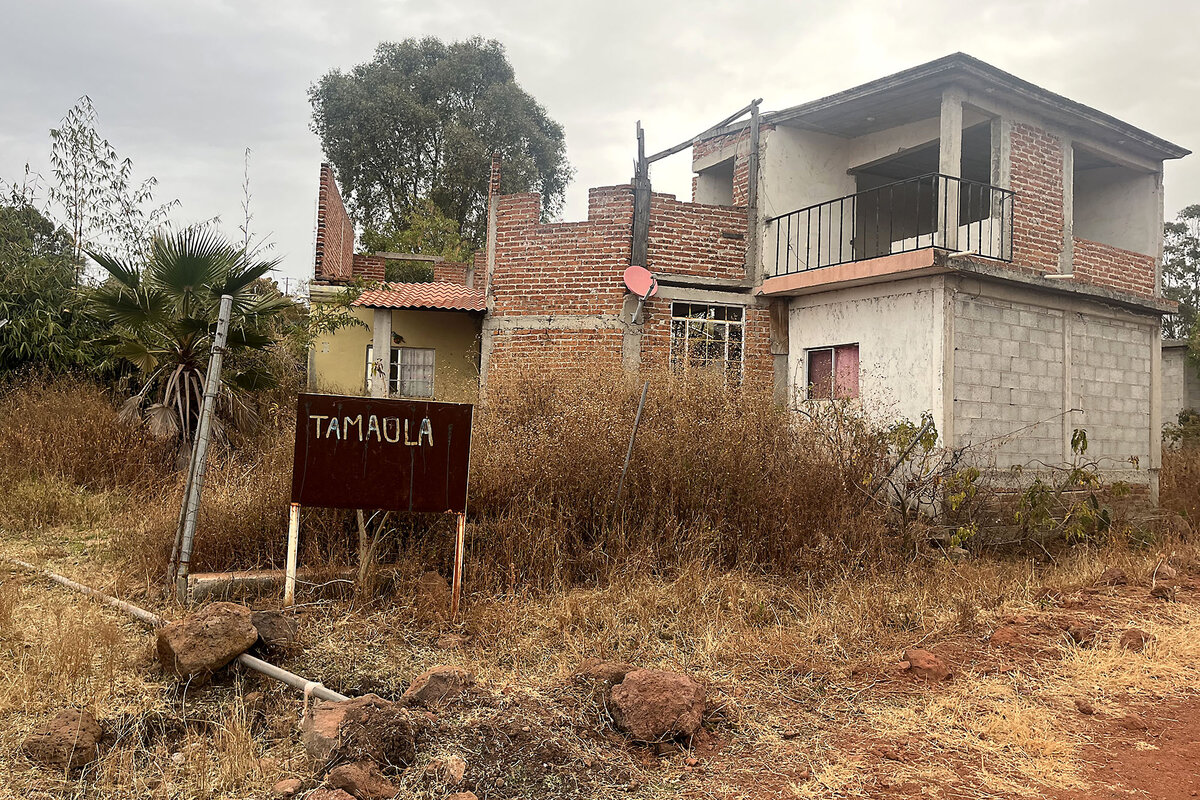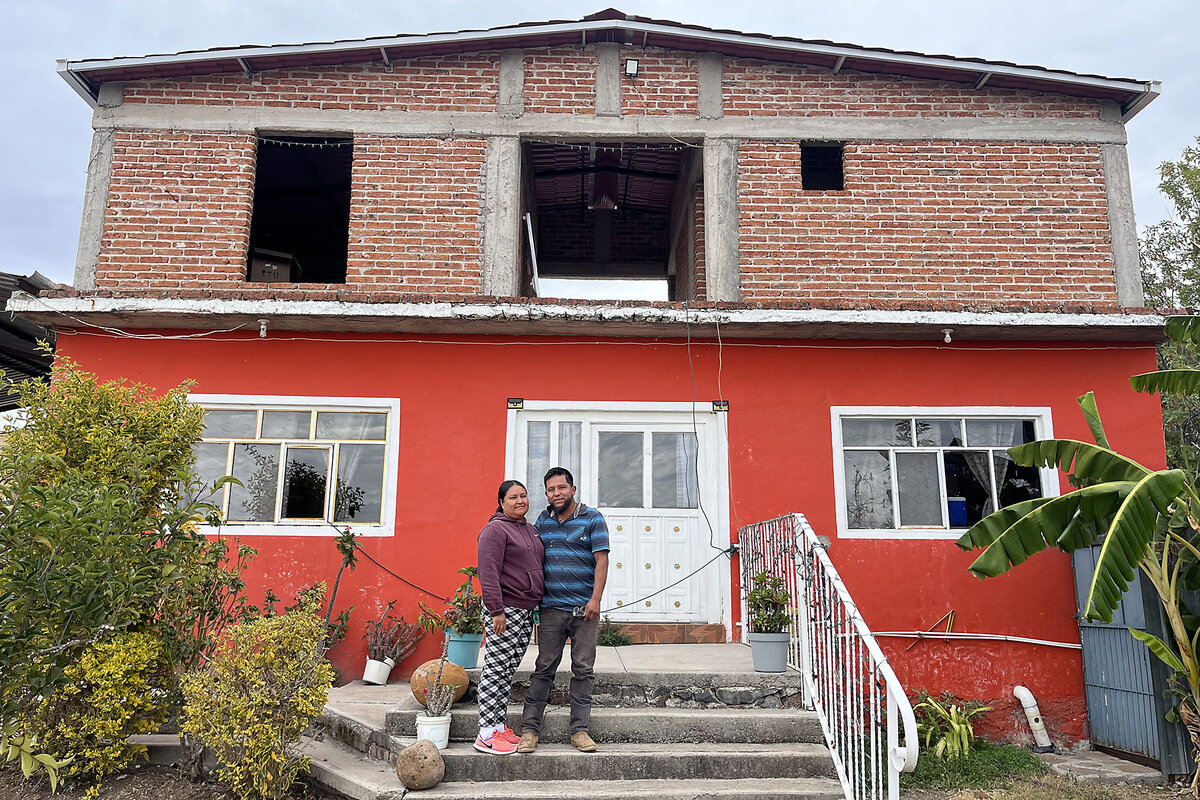Mass deportations threaten the lifeline of money migrants send back home
Loading...
| Tamahula, Mexico
The telltale signs of a community built with money earned abroad are unmistakable in this mountain hamlet.
There’s the ornate front gate outside one of the first properties in town. Brightly painted homes dot the village, many of them being expanded to a second floor. Shiny dirt bikes stand out among the donkeys and dusty trucks in the rocky backyards.
But for Juan Eduardo García, that doesn’t necessarily mean the community is better off. “Remittances have benefited individual families, built our homes, contributed to our well-being,” says Mr. García, who was 11 years old when his father first went to work in the United States without documentation.
Why We Wrote This
Many of the unauthorized migrants whom President Donald Trump plans to deport have been keeping their relatives in Latin America financially afloat with their earnings. What does their future hold?
“But more broadly speaking, no. If you look at this community over the past 50 years since it was founded, it hasn’t developed as far as water and other basic services are concerned,” he says, even though so many villagers send money home from the U.S.
Remittances are the lifeblood of many Latin American countries, contributing about 25% of Honduras’ and El Salvador’s gross domestic products and close to 20% of Guatemala’s. In Mexico, the region’s second-largest economy, remittances accounted for 3.5% of GDP, or nearly $60 billion, in 2024.
If President Donald Trump carries out his threat to deport millions of unauthorized migrants, that could cost billions of dollars in remittances. And those losses could devastate families that depend on them for everything from new homes to health care and school fees.
But there’s also an uncomfortable reality, evident in communities like Tamahula. While families are dependent on remittances from loved ones working abroad, they have little to show in terms of community development or sustainable changes in family economics. Studies show that households receiving remittances tend to have lower levels of resilience and financial security.
“Only 28.6% of remittance-receiving households can cope completely or very well with a major unforeseen expense, vs. 33.9% in households that don’t receive” money from abroad, according to a 2024 report by the international financial institution Banco Bilbao Vizcaya Argentaria.
For rural Mexicans, no work at home
Mr. García’s father sent money to build a home, where Mr. García's sister now lives. He also built a room that's become part of Mr. Garcia and his young family's home. His grandparents still depend on the dollars coming from “El Norte” to cover medical bills and roughly 80% of their monthly expenses.
This community of dirt roads and subsistence cornfields was connected to the electricity grid when Mr. García was barely a teenager, around 2014. That made it possible for him to study online for his high school diploma and college degree, and to become one of the few in his generation here to have a professional career. He works as a renewable energy engineer, traveling to his offices in a neighboring state every other week.
Migrating to the U.S. is still seen as the best way to support a family here. For those who don’t go north, construction – often building the very homes of those sending remittances – is one of the few sectors offering jobs.
“I think there are more people going [to the U.S.] for work than in previous generations,” says Gustavo García Hernández, a former classmate and neighbor of Mr. García’s who dropped out of school after sixth grade.
For the past six years, he has traveled to the U.S. to work in landscaping for six to eight months at a time on a U.S. work visa. It’s an “opportunity,” he says, gesturing toward the cherry-red home he built for his family with the money he earned in the U.S.
“Anytime I’m home, I’m out of work. It’s difficult to find employment that can maintain a family,” says Mr. García Hernández. For 40 to 45 hours of landscaping a week in the U.S., he might make $700, he says. Of that, he tries to send home two-thirds, keeping just enough to pay for his own food and rent.
He expects that the impact of mass deportations from the U.S. would be felt most heavily at the family level. “Less of everything: less meat on the table, less toys and clothes. Less income, and that affects everything,” he says.
Locals have learned lessons from past deportations, says neighbor Patricio Martínez. “People will stick around a few weeks, try to figure out how to make a living at home. But it’s always the same thing. They go back to the U.S. where they know they’ll find work.”
And if the money dries up?
Guanajuato state, where Tamahula is located, received more money in remittances last year than any other state in the country, drawing some $4.2 billion from family and friends in the U.S. between January and September.
“Income from remittances in this country is an impressive thing,” says Adriana Cortés Jiménez, who has spent her decadeslong career working on community development projects, like access to education, in rural communities in Guanajuato such as Tamahula.
“How that money is spent and where that money is going is something that needs to be studied more profoundly,” she says. “It’s so much money, and no one really knows.”
Remittances are at once the lifeblood of rural communities, and a concern.
“Once the money is here, people spend it to survive: They pay for the lights, for education, on rent and health care,” says Miguel Vilches Hinojosa, investigative professor of politics and government at the University of Guanajuato. “In the worst cases, people spend it on alcohol, drugs, things that aren’t benefiting” families or the community. But observers are still puzzled by how billions of dollars in remittances could have so little lasting impact.
Some worry that the government is shirking its responsibility to provide public services, instead expecting local citizens to fund such projects with remittance money. The result is some towns still without running water or electricity in 2025.
For nearly two decades, the Mexican government ran a program meant to help expand the reach of remittances to benefit communities more broadly. Program 3x1 matched migrant-funded investments with money from national and local governments to build roads, parks, and community centers.
The program was canceled by former President Andrés Manuel López Obrador as part of his broad austerity measures. There had been complaints that construction contracts were often unnecessarily expensive.
Guanajuato’s enormous remittance income means that “the economy is strengthened by productive activity that does not actually occur” in Guanajuato, but rather “within individual families,” says Dr. Vilches. That benefits the government: “People can pay for more electricity, more gas; people can buy more services, more merchandise.”
Back in Tamahula on a chilly afternoon in January, a mother and daughter walk home from a nearby dam, leading a donkey laden with jugs full of murky water for household chores. It’s a hilly route that takes them about 20 minutes round trip.
Despite the money flowing in from abroad, Tamahula has no running water. But villagers band together to buy potable water that is trucked in each week. Whatever happens under Mr. Trump, they say, neighbors here will continue to look out for one another.








